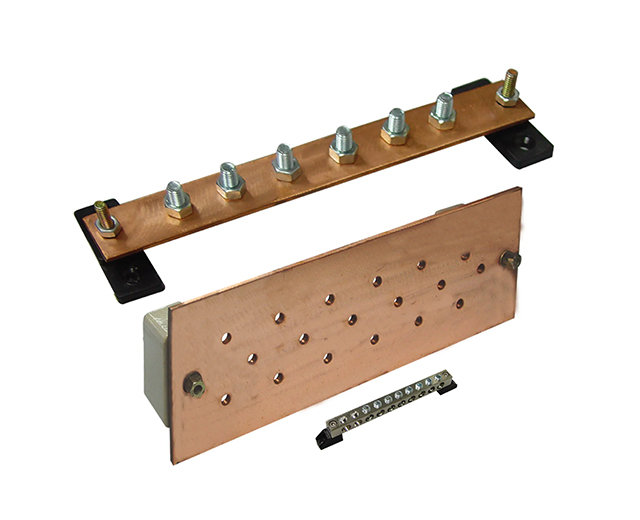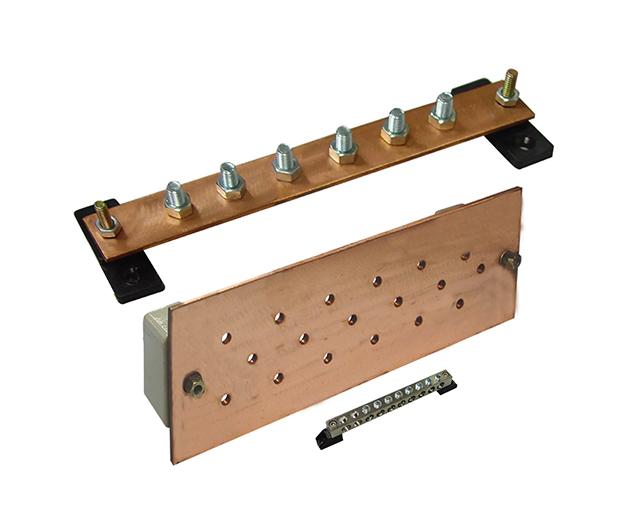

In modern electrical systems, a reliable grounding solution is critical for ensuring safety, reducing electrical hazards, and maintaining stable power distribution. The main ground bus serves as the central grounding point in industrial and commercial electrical systems, providing a secure, low-resistance path for electrical faults, lightning strikes, and static discharge. Also known as a main Ground Bus Bar or main Grounding Busbar, it plays a key role in busbar grounding and overall electrical system integrity.

A main ground bus is a conductive bar installed inside switchgear, distribution panels, control cabinets, or industrial machinery. It collects and distributes all grounding connections from equipment, enclosures, lightning protection systems, and safety devices, ensuring the entire electrical network is properly earthed.
By integrating grounding cables into a centralized electrical grounding bar, the main ground bus enhances system reliability, reduces the risk of equipment damage, and provides personnel safety in case of electrical faults.
The main ground bus bar is a solid conductive bar, typically made of high-conductivity copper or tin-plated copper. It includes pre-drilled holes or mounting terminals to accommodate multiple grounding wires, providing a flexible and secure installation solution.
Key Features of Our Main Ground Bus Bar:
High Conductivity Copper – Reduces electrical resistance and energy loss
Corrosion-Resistant Surface – Tin or nickel plating ensures long-term performance in harsh environments
Customizable Hole Patterns – Supports multiple grounding connections with different sizes (M6, M8, or per specification)
Mechanical Strength – Resists bending or deformation under high current conditions
Easy Installation – Compatible with standard electrical panels and modular grounding systems
Busbar Grounding Efficiency – Ensures minimal impedance for fault current dissipation
By using a robust main grounding busbar, facilities can centralize all grounding conductors, improving performance of the grounding system while simplifying maintenance and inspection.
A main grounding busbar is not just a copper bar—it is a crucial component in any grounding system. Its functions include:
Centralized Grounding – Collects all protective earth (PE) and neutral connections in one location
Fault Current Dissipation – Safely diverts short-circuit currents, surge currents, and lightning strikes to ground
Minimized Grounding Impedance – Reduces voltage fluctuations and electromagnetic interference
Enhanced Electrical Safety – Protects equipment, operators, and critical systems
Simplified System Management – Consolidates grounding points for easier inspection, testing, and maintenance
In short, a properly designed main ground bus bar improves overall electrical system reliability and ensures compliance with international safety standards.
Main ground buses and grounding busbars are widely used in multiple industries, including:
Industrial Automation – Protects PLCs, control devices, and motors from electrical faults
Power Distribution Systems – Provides centralized grounding in switchgear, MCC panels, and transformers
Data Centers & Telecom – Ensures stable grounding for servers, network racks, and sensitive electronics
Commercial & Residential Buildings – Integrates with lightning protection and bonding systems
Renewable Energy Installations – Solar inverters, wind turbines, and battery storage require reliable grounding
Using a high-quality electrical grounding bar guarantees efficient busbar grounding, reduces maintenance costs, and minimizes downtime.
| Specification | Options |
|---|---|
| Material | Copper, Tin-Plated Copper |
| Surface Finish | Bare, Tin-Plated, Nickel-Plated |
| Length & Width | Customizable per project requirements |
| Thickness | 3mm – 20mm (or per specification) |
| Hole Type | Pre-drilled holes for bolts or lugs |
| Installation Accessories | Insulators, mounting brackets, bolts, cable lugs |
Our main grounding busbar solutions can be fully customized to meet electrical code requirements, environmental conditions, and specific industrial applications.
Superior Conductivity – Ensures efficient fault current dissipation
Durable & Corrosion-Resistant – Reliable in harsh industrial environments
Customizable – Supports different lengths, thicknesses, and hole patterns
Compliance with Safety Standards – IEC, UL, ANSI approved
Versatile Applications – Suitable for switchgear, control cabinets, industrial equipment, and lightning protection systems
By choosing a premium main ground bus bar, you optimize your grounding system and guarantee electrical safety and performance for years to come.
Ensure contact surfaces are clean and free of oxidation
Use anti-loosening bolts or lock washers to secure grounding connections
Regularly inspect main grounding busbars for corrosion, wear, or loose terminals
Test grounding resistance periodically with professional instruments to ensure compliance
Proper installation and routine maintenance maximize the lifespan of your main ground bus and overall electrical safety.
Q1: What is a main ground bus?
A main ground bus, also known as a main grounding busbar, is a central conductive bar that collects and distributes grounding connections from various equipment, enclosures, and lightning protection systems. It ensures low-resistance paths for fault current dissipation and enhances electrical safety in industrial and commercial installations.
Q2: What materials are used for main ground bus bars?
Main ground bus bars are typically made of high-conductivity copper or tin-plated copper. Tin or nickel plating improves corrosion resistance and ensures long-term performance in harsh environments.
Q3: What is the difference between a main ground bus and a main ground bus bar?
A main ground bus refers to the overall grounding system component, while a main ground bus bar specifically refers to the solid copper or tin-plated bar within the system that connects multiple grounding cables. Both terms are often used interchangeably in electrical engineering.
Q4: Where is a main grounding busbar used?
Main grounding busbars are widely used in:
Switchgear and distribution panels
Industrial automation equipment
Data centers and telecom racks
Lightning protection systems
Renewable energy installations
They provide a centralized grounding point for safe and reliable busbar grounding.
Q5: How is a main ground bus installed?
Mount the main ground bus bar on insulated brackets or directly on the panel backplane.
Connect all grounding conductors using bolts, lugs, or terminals.
Ensure all contact surfaces are clean and free of oxidation for optimal conductivity.
Periodically check for loose connections and corrosion.
Q6: Can main grounding busbars be customized?
Yes. Main grounding busbars can be customized in:
Length, width, and thickness
Number and size of holes (e.g., M6, M8)
Surface finish (bare copper, tin-plated, nickel-plated)
This ensures compatibility with specific electrical panels and grounding system requirements.
Q7: What are the advantages of using a high-quality main ground bus?
Provides low-impedance grounding paths
Protects equipment and personnel from electrical faults
Reduces electromagnetic interference and voltage fluctuations
Simplifies maintenance and inspection
Supports compliance with IEC, UL, and ANSI grounding standards
Q8: How do I maintain a main ground bus bar?
Regularly inspect for corrosion, oxidation, and loose terminals
Keep the surface clean and free of dust or debris
Test grounding resistance periodically with professional instruments
Tighten any loose connections using anti-loosening bolts or washers
Q9: Can a main ground bus bar handle high currents?
Yes. Main ground bus bars are designed to handle high fault currents safely. The material, thickness, and mechanical strength of the bus bar ensure reliable busbar grounding even in heavy-duty industrial applications.
Q10: Why is a main grounding busbar important for electrical safety?
A main grounding busbar is critical because it:
Centralizes all protective earth connections
Provides a secure path for fault current to dissipate
Reduces the risk of equipment damage, fire, and personal injury
Enhances the overall stability and performance of the electrical grounding system